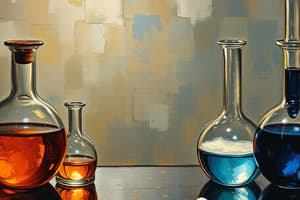Podcast
Questions and Answers
What is the chemical formula for baking soda?
What is the chemical formula for baking soda?
- CH₃COOH
- NaCl
- NaHCO₃ (correct)
- C₂H₅OH
Which consumer product is made with ethyl alcohol?
Which consumer product is made with ethyl alcohol?
- Bath Soap
- Baking Soda
- Drugs (correct)
- Vinegar
Which chemical component is generally considered safe and affordable for personal use?
Which chemical component is generally considered safe and affordable for personal use?
- Acetic acid
- Dry ice
- Essential oil (correct)
- Methane
What is the primary use of table salt?
What is the primary use of table salt?
What is the chemical name of dry ice?
What is the chemical name of dry ice?
What is the primary difference between mass and weight?
What is the primary difference between mass and weight?
Which of the following is an example of an intensive property?
Which of the following is an example of an intensive property?
Which of the following best describes a chemical property?
Which of the following best describes a chemical property?
Which separation technique is best suited for a mixture of two liquids with different boiling points?
Which separation technique is best suited for a mixture of two liquids with different boiling points?
What distinguishes extensive properties from intensive properties?
What distinguishes extensive properties from intensive properties?
How are physical mixtures characterized?
How are physical mixtures characterized?
Which of the following is NOT considered a physical property?
Which of the following is NOT considered a physical property?
What does chromatography primarily rely on to separate substances?
What does chromatography primarily rely on to separate substances?
What is the primary purpose of chromatography as a separation technique?
What is the primary purpose of chromatography as a separation technique?
Which of the following best describes filtration in separation techniques?
Which of the following best describes filtration in separation techniques?
Which method would be most suitable for separating a solid dissolved in a liquid?
Which method would be most suitable for separating a solid dissolved in a liquid?
What type of substance is formed when two or more elements chemically combine?
What type of substance is formed when two or more elements chemically combine?
Which statement correctly differentiates between homogeneous and heterogeneous mixtures?
Which statement correctly differentiates between homogeneous and heterogeneous mixtures?
How are elements defined in terms of their composition?
How are elements defined in terms of their composition?
Which separation technique involves a physical blend that preserves the identities of its components?
Which separation technique involves a physical blend that preserves the identities of its components?
What type of change does a compound undergo when formed from elements?
What type of change does a compound undergo when formed from elements?
Flashcards are hidden until you start studying
Study Notes
Separation Techniques
- Chromatography is used to separate and identify components of a mixture based on selective affinity.
- Filtration separates undissolved solid components from liquid in a mixture.
- Evaporation separates components with a dissolved solid in a liquid.
Elements
- An element is the simplest type of matter with unique physical and chemical properties.
- Elements consist of only one kind of atom.
- Elements cannot be broken down into simpler substances.
Compounds
- Compounds are substances formed when two or more elements combine through a chemical change.
- Compounds can be broken down into simpler substances.
Mixtures
- Mixtures consist of two or more substances (elements and/or compounds) that are mixed together.
- Mixtures are a physical blend of substances that preserve their identities.
- Mixtures can be solutions, suspensions, or colloids.
Heterogeneous Mixtures
- Heterogeneous mixtures have constituents that do not mix uniformly.
Homogeneous Mixtures
- Homogeneous mixtures have constituents that mix uniformly.
Distillation
- Distillation separates components of a mixture made up of two or more liquids with different boiling points.
Common Chemical Compounds & Their Uses
- Table Salt (NaCl): Sodium chloride used for food preservation.
- Baking Soda (NaHCO₃): Sodium hydrogen carbonate used in food preparation.
- Vinegar (CH₃COOH): Acetic acid used in food preservation.
- Marsh Gas (CH₄): Methane used as fuel.
- Dry Ice (CO₂): Solid carbon dioxide used to transport biological samples.
- Ethyl alcohol (C₂H₅OH): Ethanol used in the manufacture of drugs.
Matter
- Matter occupies space and has mass.
Mass vs. Weight
- Mass is a measure of the amount of matter in an object.
- Weight is the force of gravity on an object.
Physical Properties
- Physical properties are observed without changing the substance's composition.
- Examples include density, color, hardness, melting and boiling points, and electrical conductivity.
Chemical Properties
- Chemical properties are observed when a substance undergoes a chemical change.
- Chemical properties describe a substance's reactivity and its ability to form new substances.
- Examples include flammability, toxicity, acidity, and other forms of reactivity.
Types of Physical Properties
- Extensive Properties change with the amount of matter present (e.g., mass, weight, volume, thickness, surface area).
- Intensive Properties do not depend on the amount of matter present (e.g., density, color, odor, taste, hardness, brittleness).
Consumer Products
- Consumer products are final goods bought for personal use.
- Examples include bath soap.
- Consumer products are made possible by the interaction of science, technology, and society.
Product Analysis
- Consumer products have components, uses, safety levels, and costs.
- Bath soap, for example, contains essential oil, NaOH, and glycerine.
- Its purpose is to remove dirt and sweat, cure skin infections, and is generally safe and affordable.
Studying That Suits You
Use AI to generate personalized quizzes and flashcards to suit your learning preferences.




